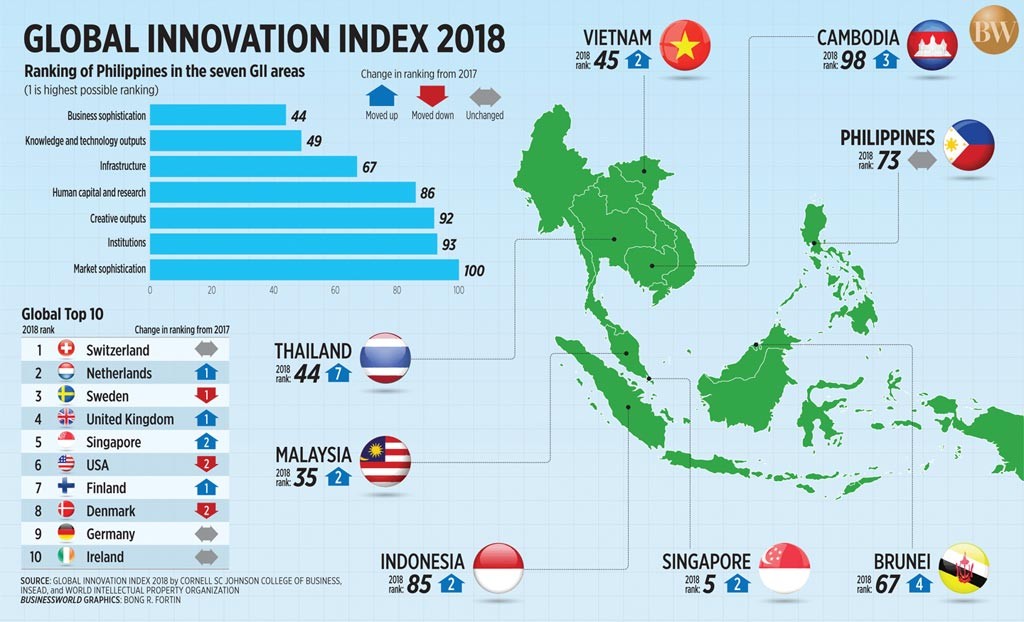
THE PHILIPPINES’ rank in terms of innovation was unchanged from a year ago, despite “high scores” in business environment, education and information and communications technology (ICT), according to an annual report of the Cornell University, INSEAD and the World Intellectual Property Organization (WIPO).
The country ranked 73rd in the 2018 Global Innovation Index (GII) out of 126 economies, steady from a year ago.
The Philippines ranked 9th among the 30 lower-middle-income countries included in the index and placed 13th among 15 countries in Southeast Asia and Oceania, which was described as “below average.”
The report said the country performed “better” in terms of innovation inputs, with its rank inching up to 82nd from 83rd in 2017.
In terms of innovation output, the Philippines fell to 68th place from 65th in the same comparative years.
The same report found the country still “quite efficient in translating its innovation inputs into outputs,” despite the decline in rank to 62nd from 55th. “Despite this downward trend, this rank is still stronger than its overall GII position (73rd),” it noted.
“The Philippines has high scores in five of the seven GII areas — Institutions, Human Capital & Research, Infrastructure, Business Sophistication and Knowledge & Technology Outputs, in which it scores above the average of the lower-middle-income group,” read the report, adding that “[t]op scores in areas such as Business environment, Tertiary education, Information & Communication Technologies (ICT), Knowledge workers, and Knowledge impact are behind these high rankings.”
“Among innovation inputs, most of the GII strengths for the Philippines lie in Market Sophistication and Business Sophistication,” the report read.
These factors involved strengths in knowledge absorption, firms offering formal training and research talent in business enterprise, trade, competition and market scale and market capitalization.
Other strengths include science and engineering graduates, as well as knowledge diffusion, productivity growth, high-tech manufacturing and ICT service exports.
The report cited the country’s weakness in institutions, as shown in terms of political stability and safety, as well as ease of starting a business.
It also noted weaknesses in human capital and research index as determined by expenditure on education, pupil-teacher ratio, tertiary inbound mobility, global research and development companies expenditure.
There were also weaknesses in ease of getting credit, ease of protecting minority investors, credit and investment, patents by origin, as well as scientific and technical articles.
At the same time, the report said that, “relative to GDP (gross domestic product), the Philippines performs at its expected level of development.”
TASKS AHEAD
Sought for comment, Philippine Chamber of Commerce and Industry President George T. Barcelon said in a phone interview yesterday that despite getting some strengths in education, the government should put more attention in advanced science, technology, engineering, and mathematics (STEM) education.
“I think the problem is in our schools. Kulang tayo sa STEM education. That’s why we still don’t have the technical capabilities unlike other countries,” he said.
“On our part, we have been focusing on innovation. We have been attending seminars in Japan on innovation and we are applying that. Our focus in our industry is really innovation and technology, research. In our industry, we have woodcraft, arts, the creative industry. We have that to help our exports apart from BPOs (business process outsourcing).”
Mr. Barcelon added: “I believe, gradually, we will improve our rank over the following years. The DoST (Department of Science and Technology) knows it, government knows it, and the private sector — we already have the awareness.”
However, despite government steps to encourage innovation — such as a law enticing Filipino scientists abroad to come home — potential innovators still have limited access to capital to fund research, especially from the government.
“I think the problem is funding. We have the students, some of them okay naman ‘yung project, pero wala silang funding. On the private side, wala namang problema doon. But the government side, we still need more,” said Mr. Barcelon.
European Chamber of Commerce of the Philippines (ECCP) President Guenter Taus cited the need for government to remove more obstacles to innovation.
“With this, we urge the current administration to continue to improve the IPR (intellectual property rights) protection and enforcement framework, as the absence of such may discourage innovation and potential investments,” he said in an e-mailed response to a request for comment.
Mr. Taus also noted the need to improve ICT infrastructure such as fiber optic networks, towers and base stations, as well as to “incentivize” the already-growing number of micro, small and medium enterprises.
“Moreover, enhancing innovation and competition in the country will achieve the long-term goals of the Philippine Inclusive Innovation Industrial Strategy in order to create jobs, attract investments, and stimulate economic growth,” Mr. Taus said.
“The ECCP remains hopeful that the government will speedily implement various measures to encourage innovation and growth. The European business community stands ready to support the Philippine government in this important undertaking.”
The report said innovation stimulates economic and human development.
Switzerland remained at the top of the 2018 index, followed by the Netherlands, and Sweden. The United Kingdom took the fourth spot while Singapore placed fifth, followed by the United States.
Finland, Denmark, Germany, and Ireland took the seventh to 10th places, respectively.
“Innovation is clearly necessary to address the energy/environment equation, but let us keep in mind that such innovation cannot be only technological. New social, economic and business models are required, including through efforts to promote smart cities, mobility solutions based on shared vehicles — and a global citizenry with better information on the impacts of various energy policies,” Bruno Lanvin, INSEAD executive director for Global Indices, said in the report.
“Ultimately, we must ensure that the solutions to our energy challenges are suited to local needs, do not entail additional disruptions and reduce inequalities.”
This article was originally published on July 12, 2018 at Business World Online.